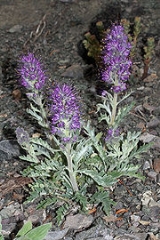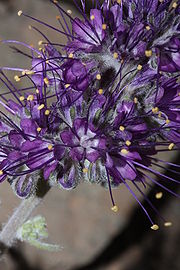
Phacelia sericea
Encyclopedia
Phacelia sericea, the Silky Phacelia, Blue Alpine Phacelia, or Sky-pilot, is a showy perennial
species of Phacelia
endemic to western North America
. Uncommon, it grows mainly at subalpine
to alpine
elevations in forest openings or above treeline among rocks and sand. It is listed by the Federal Highway Administration
as a native species suitable for landscaping along roadsides in Colorado
.
Sericea comes from the Latin sericeus, or silky, referring to the fine hairs on the leaves and stem.
 The inflorescence consists of several short panicles, tightly packed, at the end of the stem, resembling a bottle-brush. The dark blue to purple bell-shaped corolla is 4-6 mm across. It is hairy inside and out but not glandular. The filaments are two to three times as long as the corolla and give the inflorescence a fuzzy appearance. The anthers are bright yellow or orange and the style is shortly cleft. The fruit consists of two-chambered capsules with 8 to 18 seeds.
The inflorescence consists of several short panicles, tightly packed, at the end of the stem, resembling a bottle-brush. The dark blue to purple bell-shaped corolla is 4-6 mm across. It is hairy inside and out but not glandular. The filaments are two to three times as long as the corolla and give the inflorescence a fuzzy appearance. The anthers are bright yellow or orange and the style is shortly cleft. The fruit consists of two-chambered capsules with 8 to 18 seeds.
Where the ranges overlap, P. sericea ssp. ciliosa occurs at a lower elevation than ssp. sericea. These are listed as subspecies by the USDA
PLANTS database and ITIS
, and as varieties by Jepson
and Hitchcock.
Perennial plant
A perennial plant or simply perennial is a plant that lives for more than two years. The term is often used to differentiate a plant from shorter lived annuals and biennials. The term is sometimes misused by commercial gardeners or horticulturalists to describe only herbaceous perennials...
species of Phacelia
Phacelia
Phacelia is a genus of about 200 species of annual or perennial herbaceous plants, native to North and South America....
endemic to western North America
North America
North America is a continent wholly within the Northern Hemisphere and almost wholly within the Western Hemisphere. It is also considered a northern subcontinent of the Americas...
. Uncommon, it grows mainly at subalpine
Subalpine
The subalpine zone is the biotic zone immediately below tree line around the world. Species that occur in this zone depend on the location of the zone on the Earth, for example, Snow Gum in Australia, or Subalpine Larch, Mountain Hemlock and Subalpine Fir in western North America.Trees in the...
to alpine
Alpine climate
Alpine climate is the average weather for a region above the tree line. This climate is also referred to as mountain climate or highland climate....
elevations in forest openings or above treeline among rocks and sand. It is listed by the Federal Highway Administration
Federal Highway Administration
The Federal Highway Administration is a division of the United States Department of Transportation that specializes in highway transportation. The agency's major activities are grouped into two "programs," the Federal-aid Highway Program and the Federal Lands Highway Program...
as a native species suitable for landscaping along roadsides in Colorado
Colorado
Colorado is a U.S. state that encompasses much of the Rocky Mountains as well as the northeastern portion of the Colorado Plateau and the western edge of the Great Plains...
.
Sericea comes from the Latin sericeus, or silky, referring to the fine hairs on the leaves and stem.
Description
Phacelia sericea consists of several upright or ascending stems to 0.6 m (2 ft) from a tap-rooted, branched woody base. Its leaves are pinnatifid with cleft or entire segments. The basal leaves are somewhat larger than the upper cauline leaves and are more persistent and petiolate. The leaves and stems are generally covered with silvery silky hairs but are scarcely glandular.
Subspecies
Two subspecies are recognized.- P. sericea ssp. ciliosa is distributed from OregonOregonOregon is a state in the Pacific Northwest region of the United States. It is located on the Pacific coast, with Washington to the north, California to the south, Nevada on the southeast and Idaho to the east. The Columbia and Snake rivers delineate much of Oregon's northern and eastern...
and CaliforniaCaliforniaCalifornia is a state located on the West Coast of the United States. It is by far the most populous U.S. state, and the third-largest by land area...
east to WyomingWyomingWyoming is a state in the mountain region of the Western United States. The western two thirds of the state is covered mostly with the mountain ranges and rangelands in the foothills of the Eastern Rocky Mountains, while the eastern third of the state is high elevation prairie known as the High...
and ColoradoColoradoColorado is a U.S. state that encompasses much of the Rocky Mountains as well as the northeastern portion of the Colorado Plateau and the western edge of the Great Plains...
.
- P. sericea ssp. sericea is restricted to the Rocky MountainsRocky MountainsThe Rocky Mountains are a major mountain range in western North America. The Rocky Mountains stretch more than from the northernmost part of British Columbia, in western Canada, to New Mexico, in the southwestern United States...
, AlaskaAlaskaAlaska is the largest state in the United States by area. It is situated in the northwest extremity of the North American continent, with Canada to the east, the Arctic Ocean to the north, and the Pacific Ocean to the west and south, with Russia further west across the Bering Strait...
, British ColumbiaBritish ColumbiaBritish Columbia is the westernmost of Canada's provinces and is known for its natural beauty, as reflected in its Latin motto, Splendor sine occasu . Its name was chosen by Queen Victoria in 1858...
and Washington. The latter is smaller, more densely hairy, shorter, i.e., less than 0.3 m (1 ft), with relatively narrow and blunt leaf segments.
Where the ranges overlap, P. sericea ssp. ciliosa occurs at a lower elevation than ssp. sericea. These are listed as subspecies by the USDA
United States Department of Agriculture
The United States Department of Agriculture is the United States federal executive department responsible for developing and executing U.S. federal government policy on farming, agriculture, and food...
PLANTS database and ITIS
Integrated Taxonomic Information System
The Integrated Taxonomic Information System is a partnership designed to provide consistent and reliable information on the taxonomy of biological species. ITIS was originally formed in 1996 as an interagency group within the U.S...
, and as varieties by Jepson
The Jepson Manual
The Jepson Manual, Higher Plants of California is a collection of identification keys to help biologists identify the vascular plants within the state of California...
and Hitchcock.

